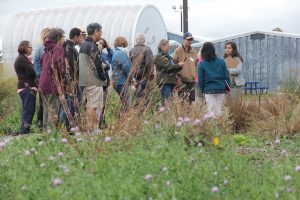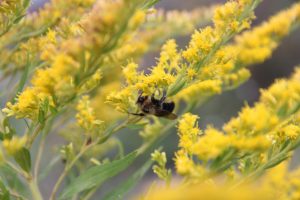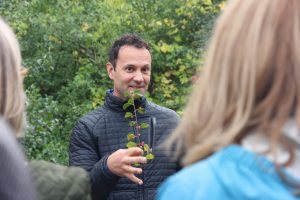BY TAYLOR LOGAN
Trafalgar Campus is getting wild.
With the addition of native plants brought to Trafalgar Campus in 2016, Sheridan has become a lively environment for wildlife.
With the addition of the gardens, Sheridan’s Mission Zero has brought workshops to campus. Pollinator workshops like Give Bees a Chance and more recently, Oakville Digs Pollinators held on Oct. 11, aim to educate the student population on the pollinator population and what Sheridan College is doing to help save the bees.
Oakville Digs Pollinators, in collaboration with the World Wildlife Fund, Carolinian Canada and Oakville Green Conservation Association, taught attendees about the key to promoting a healthy environment. The key being planting native plants.
The event started with a walk around campus hosted by Giuliana Casimirri, executive director of Oakville Green,where attendees were taught about the native and non-native plants on campus.

Dria Schilz, Sheridan student and participant at the event, said the tour was eye opening.
“It was nice to take a tour around (the gardens) and learn about all of these different kinds of native plants we had, and the history behind them,” Schilz said. “Or even how our Medicine Wheel Garden has a lot of plants that can be used in different teas and medicines. If more students were educated about them I feel like they could be better taken care of. Like pulling weeds and regularly watering them. It really opened my eyes to how important our roles are to keeping them active.”
The tour drew about 25 attendees to learn about the importance of replacing invasive species with native pollinator species, especially in Ontario’s Carolinian zone, one of Canada’s most populated areas.
Native species at Sheridan include milkweed, trilliums, elderberry, and golden rod. These plants are flourishing in Sheridan’s gardens, and attract a flurry of wildlife as well as playing an important role in protecting pollinators.

According to specialist at the World Wildlife Fund, Jarmila Becka Lee, “WWF’s Living Planet Report Canada showed that 50 per cent of monitored wildlife species are declining, and the greatest threat to species is habitat loss. Southern Ontario’s Carolinian zone is home to one-third of Canada’s at-risk plants and animals and a quarter of Canada’s human population – that’s a lot of life sharing a small space.
“What we do as individuals with this space is important for stopping and even reversing the decline of wildlife, especially since 95 per cent of the land is privately owned. Many of us don’t realize that our backyards, gardens and even balconies are habitats waiting to be restored. Helping to create or restore habitat by planting native species that wildlife depend on is the best way to strengthen not only pollinator but other wildlife populations as well.”
The event continued with a lecture by Ben Porchuk, Carolinian Zone ecologist, where he introduced the In the Zone initiative.
The initiative, started by WWF and Carolinian Canada, is a garden program which encourages people to plant native plants. Once you sign up for the initiative, In the Zone teaches you about what native plants can be brought to your backyard.
Porchuk believes that it’s a simple and easy way to bring wildlife back.
“The message is start with a single native plant,” Porchuk says. “We give people much insight on how to do this. Where to find the plants at native plant nurseries, how to design the gardens and we’ve even written booklets on how to go further in-depth by creating gardens that feature woodlands, wetlands, and prairies.”
In the lectures, attendees also learned more about invasive and native species, and the things people can do personally to help save wildlife populations.

Slides included information of plants from different kinds of gardens, woodlands, wetlands and prairies, and which plants Porchuk has in his own garden.
The lecture highlighted the importance of sharing your space with wildlife. The rise in human population goes hand in hand with the decline of wildlife. Bringing back the habitat will bring back the creatures that live there. Porchuk believes this is the most important part of conservation.
“As humans we have to start being a little more generous with our space. I think most people like lawns upon which to stretch out, to play sports, to have picnics to really relax and see all around us.” Porchuk said. “That being said I have created, and seen many other people create engaging outdoor spaces with still some lawn remaining and yet dozens if not hundreds of species of native plants. Once we bring these plants back it becomes a domino effect in inviting our native insects back, which in turn attract larger insects, which attract birds and mammals and so on. Native plants are the foundation for our ecosystems and are urban areas are vastly depleted from these critical ecosystem makers.”
